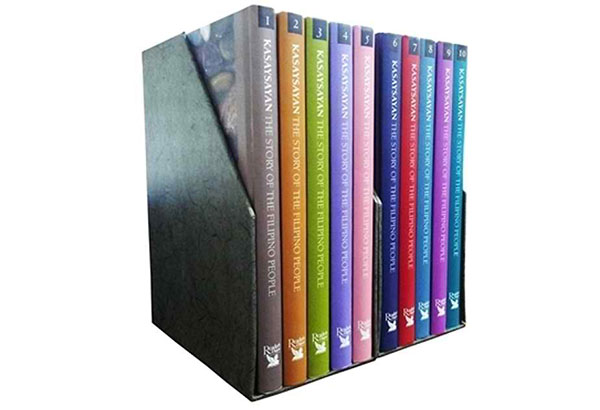A history book project like no other

Last Monday’s celebration of Independence Day reminded me of the Philippine Centennial nearly 20 years ago, when I took part in the launch of the first and still the biggest book project I’ve taken on in my professional life. I’ve edited about as many books as I’ve written — more than 30 — and 10 of those were all for one massive undertaking, Kasaysayan: The Story of the Filipino People (Asia Publishing Co., 1998).
It was a 10-volume history of the Philippines like no other, put together by some of country’s foremost historians, academics, and writers, a joint project of Reader’s Digest Asia and A-Z Direct Marketing, which was then Reader’s Digest’s local distributor at a time when the family-friendly monthly was still going strong.
The idea was hatched in 1996 in anticipation of the forthcoming Centennial between A-Z’s late president Lirio Sandoval and the indefatigable Tere Custodio, who became the project director; Reader’s Digest Asia would foot most of the bill. Their idea was that while Philippine histories and encyclopedias had existed, none of them seemed comprehensive, popularly accessible, and visually compelling enough.
Tere shopped around for an executive editor, and I think it was our mutual friend Gina Apostol who suggested me (to my everlasting gratitude). We then took on two key and stellar talents, both of them sadly now gone — Doreen Fernandez as our editorial consultant and Nik Ricio as our book designer. Together, we planned out a 10-volume series, each full-sized volume no less than 300 pages, with an average of at least one picture — many of them never published before, acquired from international and private collections — on every page, 3,500 images in all.
The volume titles previewed the series’ coverage and contents: The Philippine Archipelago; The Earliest Filipinos; The Spanish Conquest; Life in the Colony; Reform and Revolution; Under Stars and Stripes; The Japanese Occupation; Up from the Ashes; A Nation Reborn; and A Timeline of Philippine History.
To write each of these volumes, we recruited our most eminent historians and experts —people like Dr. Milagros Guerrero, Fr. John Schumacher, Dr. Ricardo T. Jose, and Dr. Ma. Serena Diokno. Each volume was also supplemented by around 20 essays, contributed by the country’s top writers and cultural figures from Dr. Bienvenido Lumbera to Jessica Zafra — on topics ranging from early forms of Philippine writing and wartime “Mickey Mouse” money to 16th-century Visayan warriors and the origins of the kundiman. (My own single contribution as a writer to the series was an essay on the First Quarter Storm.)
It seemed like a gargantuan project, and indeed it was, requiring not only the production of enormous amounts of historical scholarship and pictorial research (the latter task headed by no less than Romy Gacad) but also the management of a budget hitherto unheard of in local publishing and, more dauntingly, of over 200 egos. I also organized a small team of sub-editors to help me get the job done, and sent them memos emphasizing the need for readability; every author’s brief, after all, was “to write in a style that can be understood by the Filipino high school and college student, without compromising the seriousness of the work as history.” The Internet in the Philippines was in its rudimentary stage; we had email, but still moved files around in floppies.
We gathered the editorial team for the first time one day in January 1997, setting for ourselves the formidable goal of launching 10 new, profusely illustrated books in June 1998, or 18 months hence. Against all odds, that goal was met. I would write as a promotional blurb at the end that “Here, finally, is the story of the Filipino: told from a Filipino viewpoint, but with a full appreciation of the modern Filipino’s engagement in a rapidly globalizing society.”
That priceless experience would teach me everything I needed to know as a textual editor, leaving much of the people management to the thoroughly professional and unwavering Tere. Including the essays, I read, edited, and proofread a million words; I sat side-by-side with Nik poring over the layout, adjusting the text to remove — as the perfectionist in him demanded — rivers, widows, and orphans (publishing terms you’d do well to Google), and writing and positioning subheads for visual relief.
One more task remained for me, which was to draft speeches for the two principal guests of honor at the grand book launch at the Manila Hotel on June 1 — President Fidel V. Ramos and former President Corazon Aquino. I’ve sadly lost the draft I did for Cory, but I still have notes that have FVR saying:
“If the art of narrative or of storytelling is the art of making sense of seemingly random or disparate events, then Kasaysayan is our story, our understanding of ourselves, our version of the same events that other writers have used to keep us subjugated and alien unto ourselves. Written from our point of view, this version — this vision — is one that must empower us, that must make us whole, that must enable us to better ourselves and our future. We cannot change history, but history can change us.”
The handsomely boxed 10-volume set initially sold for P16,000; a few months ago I learned that surplus sets were being marketed in some Manila bookstores for as low as P2,000. That sounds to me like the bargain of the century — especially if you have a teenager in the house in need of a sense of history, or just want to see our history in a way you never did before.
* * *
Email me at jose@dalisay.ph and visit my blog at www.penmanila.ph.



















